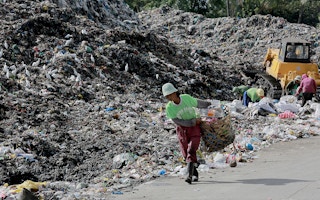Even as fierce debate on plastic pollution and single-use packaging continues in the Philippines, it is vital to address the lack of disposal facilities and stop the leakage of plastic waste into the oceans, industry experts said.
The use of plastic packaging by food and consumer goods companies has been blamed for the marine pollution crisis, but no other material is as effective in ensuring the safe transportation of food, Crispian Lao, head of the Philippine Alliance for Recycling and Materials Sustainability (PARMS), pointed out.
“If there is packaging that meets the demand of food safety and accountability in an archipelagic country like the Philippines, where food has to be transported from one island to another, then we are very much open to that,” said Lao, whose multi-sectoral organisation aims to develop zero-waste programmes for schools and communities.
“But we are still in the process of looking for those solutions, so right now, we need to address problems as they come. What is important for now is to ensure that none of the waste enters our ecosystem.”
After China and Indonesia, the Philippines ranks as the world’s third biggest polluter, with 2.7 million metric tonnes of plastic waste generated each year.
Although the Philippines has a high garbage collection rate among Southeast Asian countries, rubbish is not properly disposed of, according to a 2018 study of waste management practices in the region.
Lao said 70 per cent of the Filipino population has no access to disposal facilities and sanitary landfills, causing waste to leak into the oceans.
While the Philippines enacted a solid waste management law nearly 20 years ago to convert all open dumpsites into sanitary landfills, government data shows that there are still 403 open dumpsites and 108 controlled dumpsites in the country.
“
If there is packaging that meets the demand of food safety and accountability in an archipelagic country like the Philippines, where food has to be transported from one island to another, then we are very much open to that.
Crispian Lao, founder, Philippine Alliance for Recycling and Materials Sustainability (PARMS)
The low compliance of cities to establish sanitary landfills has been blamed on the high cost of closing dumpsites, but Lao argued that regulations for building landfills are also “too strict”.
Among other requirements, landfills must be built on clay, and at a distance from earthquake faults. But the country has very little clay and sits on several tectonic plates, he said.
Collected waste leaking into the oceans
Czarina Constantino, who spearheads the World Wide Fund for Nature’s (WWF) global campaign in the Philippines to stop the flow of plastics into nature by 2030, agreed that the lack of waste disposal facilities is one of the main causes of plastic pollution in the country. Poorly resourced municipal governments are the reason for this.
According to a 2018 report by WWF, up to 74 per cent of plastic in the Philippines that ends up in the ocean is from waste that has already been collected.
The report said that 386,000 tonnes of waste are leaked into the ocean every year because of hauler dumping—where private hauler companies unload their trucks into water bodies on the way to proper disposal sites in order to cut costs—and because of poorly located dumps situated near waterways.
The low recycling rate of low-value plastic material contributes to the marine litter problem, Constantino added.
“In the Philippines, recycling is focused on high-value plastics like polyethylene terephthalate (PET) and high-density polyethylene (HDPE) that is readily available in junk shops, but there is very limited infrastructure for recycling of low-value plastics like single-use sachets, which usually ends up in landfill,” she told Eco-Business.
Single-use sachets—typically made of fossil fuel–based chemicals that are meant to be disposed of right after use—have been a mainstay in low-income households in the country, where tingi-tingi, or a retail culture, is prevalent. Not all consumers can afford to buy products in bulk, and sachets allow them to purchase items such as coffee, shampoo and detergents in small amounts.
The shortage of recycling facilities in the country is due to a lack of space to install them in congested areas, said Constantino. Apart from the actual recycling plant, the local waste management system also requires a materials recovery facility, which is a specialised plant that segregates materials for recycling and prepares them for marketing to end-user manufacturers.
Cities also struggle with a lack of funding for recycling infrastructure, although the government has started to push for cluster sanitary landfills, where local government units may share financial resources to establish sanitary landfills. There are currently only five recycling companies in the Philippines, but solid waste generation has steadily increased from 37,427 tonnes per day in 2012 to 40,087 tonnes in 2016.
Businesses are not exempt from the war on waste
The non-profit Alliance to End Plastic Waste acknowledged that waste disposal systems of countries like the Philippines may not be designed to cope with the volumes of trash generated from consumer goods.
However, brand owners and other stakeholders such as producers, retailers and waste management companies need to come together to develop solutions to reduce plastic pollution, said Jessica Lee, its vice-president of communications. The Alliance to End Plastic Waste, based in Singapore, comprises some the world’s biggest plastic producers and users that have set up a US$1.5 billion fund to improve waste collection and recycling in developing countries.
Lee cited a study released in January by think tank Green Alliance that revealed how alternative materials like paper and glass may generate higher carbon emissions than plastic or aluminium.
“If businesses don’t come together to address the waste issue, there will be actions which trigger the usage of alternative materials that may bring about an even bigger challenge that the modern lifestyles of eight billion people in the world bring,” Lee told Eco-Business.
“
If business don’t come together to address the waste issue, there will be actions which trigger the usage of alternative materials that may bring about an even bigger challenge that the modern lifestyles of eight billion people in the world bring.
Jessica Lee, vice-president of communications, Alliance To End Plastic Waste
Food manufacturer Mondelez Philippines is making efforts to tackle plastic waste through management and recycling.
The snacks giant, known for products such as Cadbury chocolate and Oreo cookies, recognised the need for a multi-strategy approach to address waste including reducing plastic use, developing alternatives to plastic packaging, and recycling.
“We still cannot eliminate sachets because they are the best means to preserve freshness and shelf-life… we are not removing them until we are certain that replacement will be just as effective,” said Mondelez Philippines’ corporate & government affairs country manager Kristoffer Rada.
Parent company Mondelēz International is trying out various packaging technologies. For instance, it trialled a 100 per cent recyclable paper packaging that does not contain laminates, foils or plastic in one of its products in New Zealand and Australia last year.
Mondelez Philippines also supports the idea of the extended producer responsibility (EPR), which makes various companies responsible for the entire life cycle of plastic products, Rada said.
“
Plastic in itself is not evil. It is the disposal of it. We have to see that we are working towards a solution.
Kristoffer Rada, country manager, Mondelez Philippines
The company is auditing the volume of plastic it uses to set more concrete take-back targets. One of the early ways it is helping recycle is by repurposing plastic into eco-bricks for schools.
Globally, Mondelēz International is also making 100 per cent of its packaging recyclable by 2025. On the homefront, the company is working with PARMS for a zero net waste commitment by 2030.
To boost recycling facilities in the country, the conglomerate has contributed US$30,000 to the construction of a recycling facility in Parañaque City. Together with PARMS and its member companies, it can churn out 100 to 200 eco-bricks a day from 60 to 120 kilogrammes of plastic waste once operational.
Rada said: “Plastic in itself is not evil. It is the disposal of it. We have to see that we are working towards a solution. We are doing this through education and by partnering with NGOs.”











